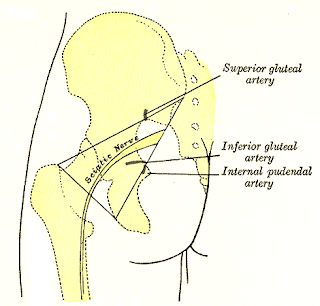If I had a dime for every time I have heard this from friends, students and patients, I would be doing all right! Usually, any time someone gets a pain in the back that travels below the buttock, they believe they are suffering from sciatica. And some of them may be right, but others could have something else going on. So before we go any further, let’s step back and try to define what sciatica is, which is easier than that might seem, as it is really a symptom, not a medical condition or disease. What that means is that even if you do have sciatica, you are just at the beginning of a journey to find out the underlying cause of you symptom.
Sciatica gets its name because of the relationship to one of the body’s important nerves, the sciatic nerve, which is really made up of several nerve roots from the lower lumber and sacral region of the spine. These separate nerve roots emerge from the sides of the spine and join together to make a bigger nerve that travels down the back of the legs all the way to the feet. It has a couple of jobs: it supplies sensation to the muscles of the backs of the knees and lower legs, and it also provides sensation to the backs of the thighs, part of the lower legs, and the soles of the feet.
Let’s take a look at what the NIH, National Institutes of Health (see here) have to say about sciatica:
Sciatica refers to pain, weakness, numbness, or tingling in the leg. It is caused by injury to or pressure on the sciatic nerve. Sciatica is a symptom of another medical problem, not a medical condition on its own.
Sciatica usually affects people on just one side of the body. And it turns out that the "symptom" called sciatica is actually a constellation of other symptoms. Here’s what the NIH has to say about that and the pain associated with sciatica:
Sciatica pain can vary widely. It may feel like a mild tingling, dull ache, or a burning sensation. In some cases, the pain is severe enough to make a person unable to move. The pain most often occurs on one side. Some people have sharp pain in one part of the leg or hip and numbness in other parts. The pain or numbness may also be felt on the back of the calf or on the sole of the foot. The affected leg may feel weak. The pain often starts slowly. Sciatica pain may get worse:
- After standing or sitting
- At night
- When sneezing, coughing, or laughing
- When bending backwards or walking more than a few yards, especially if caused by spinal stenosis
A few of the more serious and common causes include a slipped disc in the lower lumbar area of the spine, Piriformis Syndrome (a condition associated with a deep muscle in the buttock area beneath the gluts that comes in contact with the sciatic nerve as it heads down the leg), pelvic injury and fracture (which could include sacroiliac dysfunction, a not uncommon problem for yoga students) and tumors.
Interestingly, a lot of cases of sciatica will resolve on their own without a lot of testing or heavy duty treatment. In the old days, they used to recommend bed rest for these kinds of symptoms, but we know now that it is prudent, after a brief period of rest, no more than a few days, that gradual return to everyday activities can be helpful, with gentle spinal movement and core strengthening very helpful for recovery. This is, of course, one way yoga can help. In fact, yoga is an excellent way to promote gentle spinal movements, safely strengthen the abdominal area and the lower back muscles, as well as stretch several muscle groups that are associated with general lower back pain that could include sciatica, such as the psoas and the piriformis muscles.
In addition to acute treatment with over the counter meds like ibuprofen and acetaminophen, as well as ice and heat, the NIH also makes the following recommendations for early treatment:
Bed rest is not recommended. Reduce your activity for the first couple of days. Then, slowly start your usual activities after that. Avoid heavy lifting or twisting of your back for the first 6 weeks after the pain begins. You should start exercising again after 2-3 weeks. This should include exercises to strengthen your abdomen and improve flexibility of your spine. (Go yoga!)
If your symptoms are not improving, you are having weakness in one leg, you noticing a foot is kind of drooping when you walk, or you have difficulty controlling your bowels or bladder, don’t put off a visit to your doc—schedule is as soon as you can. In these situations, you might need more evaluation, which might include X-rays, MRIs or local injections to help reduce swelling around your nerves if they are determined to be the culprits.
And if you are going to utilize yoga as a healing tool, look for the most qualified and experience teacher around to work with. Later this week I will share the experiences of a good friend and colleague of mine who had sciatica arise during a retreat a few years back and the almost miraculous technique he learned to eliminate this symptom.


























